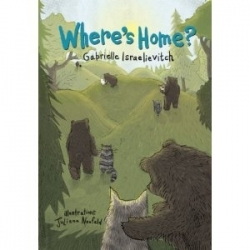
Where's Home?
Littleprints is one of the many, many kittens of Mr. and Mrs. Bob Cat. With so many kittens, the Bob Cats sometimes ignored the little ones and let them roam and play without making sure they were safe. Other times, the Bob Cats hissed and scratched at each other, leaving the kittens to huddle under the couch and wait for the fights to be over. Scary as it could be, “it was the only life they knew,” and Littleprints found ways to comfort himself. When the kittens are taken away from their parents, Littleprints must face new fears and obstacles as he tries to find a new home, and maybe even become part of a happy, loving family.
Through Littleprints and his family, Gabrielle Israelievitch’s Where’s Home? explores the complex, conflicting emotions of children who have experienced traumatic or neglectful homes as well as the fears and uncertainty that come with trying to move on. Israelievitch’s work as a child psychotherapist adds insight to this authentic story with which children will be able to identify, and from which caregivers can learn.
The authentic situation and its accompanying emotions could easily become too dark for children, but Israelievitch avoids melancholy. Told from Littleprints’s perspective, the book captures every event in a childlike tone. There is deep sadness here, but ultimately this is a hopeful story; Littleprints finds safety, love, and a family. His experience will reassure children that they can recover from their troubles and fears.
Younger foster and adopted children, especially those who have experienced abuse or neglect, will benefit from this story, as will their parents and caregivers. The story is designed to be read and shared between a caregiver and child, which will give children the opportunity to work through emotions that might be stirred up.
Children who have not experienced what Littleprints goes through might be dismayed; by the end of the book they will gain a deeper understanding of what other children go through. This makes the book a unique resource for children living with foster children.
Since the book is intended for younger children, the writing is simple, but moving, and teachers, caregivers, and parents will find it a good tool for connecting with victims of troubled families. Eventually, Littleprints “notices for the first time he is looking forward,” and his journey will help others to do the same
Reviewed by
Alicia Sondhi
Disclosure: This article is not an endorsement, but a review. The publisher of this book provided free copies of the book to have their book reviewed by a professional reviewer. No fee was paid by the publisher for this review. Foreword Reviews only recommends books that we love. Foreword Magazine, Inc. is disclosing this in accordance with the Federal Trade Commission’s 16 CFR, Part 255.
